Hammering Man is a series of monumental kinetic sculptures by Jonathan Borofsky. The two-dimensional painted steel sculptures were designed at different scales, were painted black, and depict a man with a motorized arm and hammer movement to symbolize workers throughout the world. They were structurally engineered by Leslie E. Robertson Associates (LERA).

Waiting for the Interurban, also known as People Waiting for the Interurban, is a 1978 cast aluminum sculpture collection in the Fremont neighborhood of Seattle. It is located on the southeast corner of N. 34th Street and Fremont Avenue N., just east of the northern end of the Fremont Bridge. It consists of six people and a dog waiting for public transportation — specifically, the Seattle-Everett Interurban. While the interurban railway ran through Fremont from 1910 until 1939, it stopped on Fremont Avenue rather than N. 34th Street, which the statue faces.

DNA Tower, a public sculpture by American glass artist Dale Chihuly, is in the Morris Mills Atrium of the VanNuys Medical Science Building, on the campus of Indiana University-Purdue University Indianapolis (IUPUI), which is near downtown Indianapolis, Indiana. It was commissioned for the Indiana University School of Medicine through a gift from an anonymous donor and was dedicated on September 30, 2003.
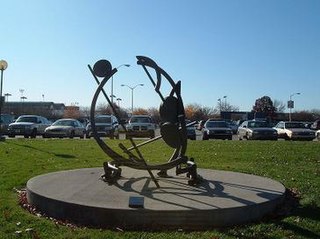
Entangled, 2004, is an abstract sculpture created by Indiana-based artist Brose Partington. The sculpture is located on the Indiana University-Purdue University Indianapolis (IUPUI) campus at the Herron School of Art and Design, 735 W. New York Street in Indianapolis, Indiana, in the United States. It was given to Herron by Ezra Freidlander and Linda H. Freidlander in 2005.

Indiana Limestone, a public sculpture by Italian-American artist Adolfo Doddoli, is located on the Indiana University-Purdue University Indianapolis campus, which is near downtown Indianapolis, Indiana. The sculpture is located on the east corner of the north side of the lecture hall under the overhang. The lecture hall is located at 325 University Boulevard in Indianapolis, Indiana. The sculpture was commissioned for the Indianapolis University-Purdue University Indianapolis's (IUPUI) campus in the mid-1970s. It was installed by the artist.

American Legion Soldier is a public artwork by German-born American artist Adolph Wolter, located at the American Legion building on K Street, N.W. in Washington, D.C., United States. "American Legion Soldier" was surveyed as part of the Smithsonian's Save Outdoor Sculpture! program in 1993.
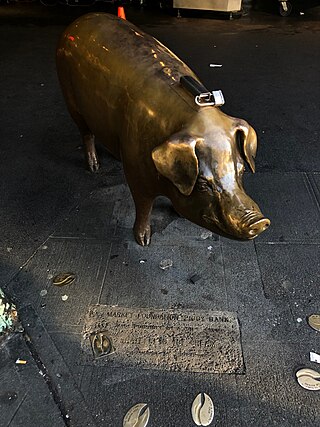
Rachel, also known as Market Foundation Piggy Bank, Rachael the Pig, Rachel the Pig or Rachel the Piggy Bank, is an outdoor bronze sculpture of a piggy bank, designed by Georgia Gerber and located at Pike Place Market in Seattle, Washington, in the United States. It was dedicated on August 17, 1986, the market's 79th birthday, and is maintained by the Pike Place Market Foundation. Modeled after a pig that lived on Whidbey Island and was the 1985 Island County prize-winner. In 2006 Rachel received roughly $9,000 annually while in 2018, donations increased to $20,000. The money is collected by the Market Foundation to fund the Market's social services.

Talos No. 2 is an outdoor 1959–1977 bronze sculpture created by the American artist James Lee Hansen. It is located in the Transit Mall of downtown Portland, Oregon, in the United States.

Trigger 4, also known as Trigger Four, is an outdoor 1979 steel sculpture by Lee Kelly, located on the Reed College campus in Portland, Oregon.

Soaring Stones, also known as Rouse Rocks, Soaring Rocks, and Stones on Sticks, is a 1990 granite-and-steel sculpture by John T. Young. It was first installed in the Transit Mall of Portland, Oregon, and was later sited as Soaring Stones #4 at Whitman College in Walla Walla, Washington. The sculpture was commissioned for $100,000 to replace a fountain that was removed during construction of Pioneer Place.
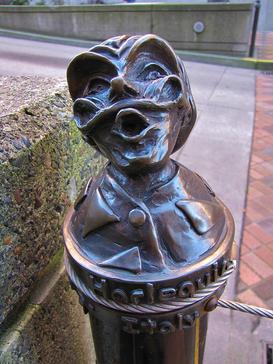
Folly Bollards is a series of outdoor 1998 bronze bollard sculptures by Valerie Otani, installed along Southwest Main between Broadway and Park in Portland, Oregon, United States.

Big Red, also known as Red, is an outdoor 1974 steel sculpture by Bruce Beasley, installed at West 7th Avenue between Washington and Jefferson streets in Eugene, Oregon, United States.
Ode to a Tree is an outdoor 1977 sculpture by Le Roy Setziol, installed on the Oregon State University campus in Corvallis, Oregon, in the United States.

Dancer with Flat Hat is a sculpture by Phillip Levine.

Wind Cradle is an outdoor 1976 stainless steel sculpture by Ali Baudoin, installed at the Seattle Central College campus in Seattle, Washington, in the United States.

The Seattle George Monument, also known as Seattle, Washington Monument, is an outdoor 1989 sculpture by Buster Simpson, installed outside the Seattle Convention Center, north of 7th Avenue between Union and Pike Streets, in Seattle, Washington, in the United States.
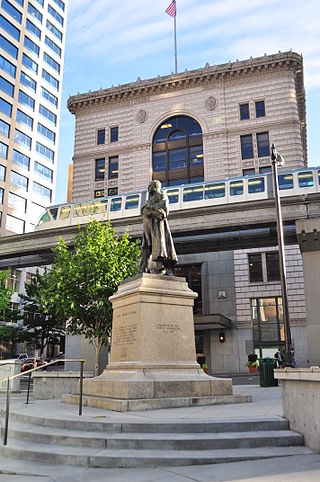
John Harte McGraw is an outdoor 1912 bronze sculpture depicting the former governor of the same name by Richard E. Brooks, installed in McGraw Square at the intersection of Fifth Avenue and Olive Street in Seattle, in the U.S. state of Washington.
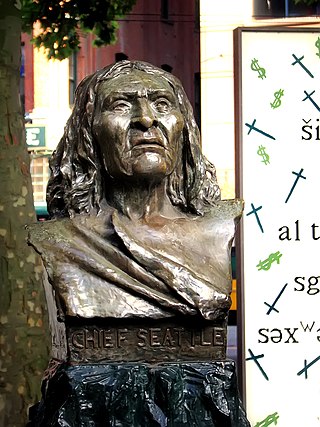
Chief of the Suquamish – Chief Seattle, also known as Bust of Chief Seattle and Chief Seattle Fountain, is a bust depicting Chief Seattle by artist James A. Wehn. It was commissioned by the Seattle Park Board to accommodate the Alaska-Yukon-Pacific Exposition, and initially sat on a fountain for men, dogs and horses.
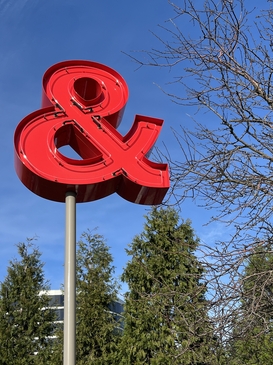
Love & Loss is an outdoor 2005 mixed-media installation by Roy McMakin, installed at Olympic Sculpture Park in Seattle, Washington.

















